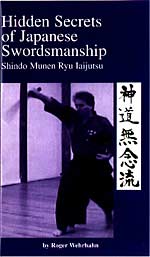Video Review
Hidden Secrets of Japanese Swordsmanship: Shindo Munen
ryu Iaijutsu
(Tape 2 Of Series)
Video by Roger Wehrhahn. (VHS 59 Minutes)
Hawley, PA: Mountain Teachings

Review by Deborah Klens-Bigman, Ph.D.
In this latest of Roger Wehrhahn’s video tapes on iaido and iaijutsu,
he introduces viewers to kata from the Shindo Munen ryu. The style is
based on Shinkage ryu, Shinkage Ichien ryu and Ichien ryu styles. Wehrhahn
relates a brief history of the style, shows the proper etiquette and
then leads the viewer through 12 tachiwaza kata (standing forms), including
views at different speeds and from different angles.
The best part of the tape, from a teacher’s point of view, is
the very beginning. Wehrhahn correctly spends some time on basics, such
as proper tenouchi (grip on the sword) and how to make a proper kirioroshi
cut. He points out some common errors and solutions which are relevant
to nearly every style of Japanese swordsmanship. Rather than get to the “good
stuff” right away, Wehrhahn wisely spends some time on what actually
makes the good stuff good. At times, he judiciously uses still photos,
notably to show proper and improper grip.
Wehrhahn next goes through each of the 12 forms in a fairly straightforward
manner, at slower and “regular” speed, from different angles.
Except for rare top-down shots, in which he shows how some forms that
end up off the center line are finished by moving back to the center
line, the changes in speed and angle are done by Wehrhahn himself. While
a static camera may not be very interesting to the viewer, it is somewhat
refreshing to not see a martial arts tape that is tricked-up in post
production.
One of the best things about iaido and iaijutsu in general is that the
bunkai (applications) of the forms are always practical. Though kata
are by nature theoretical, iaido and iaijutsu kata always relate to specific
situations as stories of attack and defense. For example, in a kata pitting
the swordsman against two opponents, the techniques are arranged such
that the defender might ward off one attacker before dispatching the
second one, then returning to finish off the first.
Wehrhahn shows the bunkai of some of the Shindo Munen forms, but not
all, which is somewhat disappointing, though what he does show is certainly
worthwhile. I would have especially liked to have seen the bunkai for
the 4th kata, Utsuseme, which features three thrusts and two cuts. I
am not sure what the reasoning was to show some bunkai but not others,
but it’s too bad, as bunkai makes the kata, which sometimes seems
like abstract movement, absolutely clear.
As I noted in my previous review of “Hidden Secrets of Japanese
Swordsmanship: the Omori ryu,” Wehrhahn’s posture is always
excellent and his technique generally very good. That said, however,
there are two technical points in “Shindo Munen ryu” that
bear mentioning.
Many of the 12 kata end with the practitioner coming to seigan no kamae.
Seigan is a position where the sword is held in both hands, tip pointing
forward, usually towards the opponent’s eyes or throat. I could
not help but notice that Wehrhahn’s seigan was a bit high - the
only way it would be in the opponent’s eyes would be if the opponent
was very close to him at the end of the form. This is unlikely, given
the nature of sword forms. While this is a small point, experience has
taught me that students will imitate techniques exactly, especially at
the beginning of their training. Any variation in form or technique will
instantly be picked up and passed along.
The second technical point is perhaps more important. As a style, the
Shindo Munen forms rely heavily on turning the saya (sheath) over so
the edge of the sword is down as it is being drawn for kiriage (low-high
diagonal cut) targeting the opponent’s forearm. This is a difficult
technique, not practiced in other styles to the extent it is here. However,
I could not help but notice the sound of the sword scraping against the
saya during many of Wehrhahn’s draws. The problem with the sound
of the sword against the inside of the saya is that a real, surgically
sharp katana will cut through a wooden saya, and into the practitioner’s
hand, easily. Given that there is a large vein between the thumb and
forefinger, the consequences of cutting oneself here can be serious.
Some practitioners line the inside of the saya with horn to minimize
the possibility of cutting through; however, swords were in fact designed
and tested to cut through bone, so this is, at best, a partial solution.
Eventually, the sword will wear through the horn, perhaps without the
practitioner’s being aware of it. Turning the saya with the draw
is somewhat dangerous, therefore, and needs to be done properly (it is
correct when the draw makes no sound at all). Wehrhahn would have done
well to pay more attention to the draw during the “basics” section.
While I consider these two points to be important enough to mention,
they are small, given the overall quality of the tape. Though I would
recommend “Hidden Secrets of Japanese Swordsmanship: The Omori
ryu” to Muso Shinden ryu iaido students regardless of their level
of training, “Shindo Munen ryu” might be made better use
of by more advanced practitioners who can analyze the techniques being
shown.
In spite of these minor flaws, “Hidden Secrets of Japanese Swordsmanship:
Shindo Munen ryu” is very worthwhile for experienced iaido practitioners
interested in seeing a lesser-known, beautiful style of swordsmanship.
I am looking forward to seeing the rest of the “Hidden Secrets” series.
This video is available from the FightingArts Estore:
Hidden Secrets of Japanese Swordsmanship:
Shindo Munen
ryu Iaijutsu
Video by Roger Wehrhahn.
Hawley, PA: Mountain Teachings
VHS 59 minutes
RW-V-5002
US$49.95.
(+$5 shipping within US

|